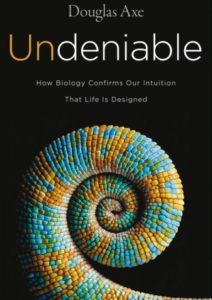Jay L. Wile's Blog, page 37
August 22, 2016
Coral Bleaching: A Death Sentence or An Adaptive Mechanism?

A coral reef in the Phoenix Islands Protected Area, near Coral Castles (click for credit)
I do a lot of scuba diving, and I love coral reefs. They are probably the most beautiful things you can see under water, and they are usually teeming with fish and other wildlife. While there are other wonderful things to see in the ocean, I can’t think of anything better than nearly depleting a tank of air while slowly swimming over and around a coral reef.
However, there are times when coral reefs aren’t so beautiful. Compare the picture above, for example, to the following picture:
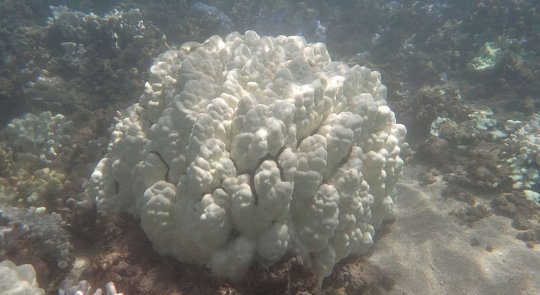
Bleached coral (click for credit)
What’s the difference? The coral pictured above has bleached.
Corals have an amazing mutualistic relationship with microscopic algae called zooxanthellae. The corals provide protection and certain necessary chemicals to the zooxanthellae. In exchange, the zooxanthellae make oxygen, sugar, and other chemicals for the corals, and they also help the corals remove waste. It is a relationship that works wonderfully for both of them. However, there are times when corals expel their zooxanthellae. This causes them to turn white (as shown in the picture above), which is why it is called “bleaching.”
Why do corals bleach? The honest truth is that we don’t know. While you often hear that bleaching is caused by the water becoming too warm, it can also happen when the water becomes too cold. Pollution can also cause it. Thus, the most accurate thing to say right now is that corals tend to bleach when they are “stressed.”
Why am I writing about corals and bleaching? Because I ran across a story in the New York Times about a coral reef called Coral Castles, which is located in the Phoenix Islands Protected Area.
In 2003, the waters of Coral Castles got very warm, and a large portion of the corals bleached. Even though corals do not die when they bleach, the article says that researchers had declared the reef “dead.” Why? Because when they bleach, corals are not as well-equipped to perform the basic tasks necessary to stay alive, so they are more likely to die when they bleach than when they have their zooxanthellae. I assume that if researchers really did declare the reef dead (I couldn’t find anything from 2003 that indicated this), it was because they thought that with so many corals at such a disadvantage, there was no way the reef could recover.
However, it most certainly did recover. The article reports on the observations of a research team that recently went to examine the area:
This month, the Massachusetts-based research team finished a new exploration of the reefs in the secluded Phoenix Islands, a tiny Pacific archipelago, and were thrilled by what they saw. When they splashed out of an inflatable dinghy to examine Coral Castles closely, they were greeted with a vista of bright greens and purples — unmistakable signs of life.
“Everything looked just magnificent,” said Jan Witting, the expedition’s chief scientist and a researcher at Sea Education Association, based in Woods Hole, Mass.
Obviously, then, coral reefs can recover, even from major bleaching events. That’s really good news!
But there’s more to it than that. This recovery brings up the question, “Why do corals bleach in the first place?” As I noted earlier, when corals are “stressed,” they bleach. However, that doesn’t really answer the question, does it? What is it about being “stressed” that causes them to expel their zooxanthellae?
I have no answer to that question, but I did run across an interesting hypothesis put forth by Jim Steele, the director emeritus of the Sierra Nevada Field Campus at San Francisco State University. He claims that corals expel their zooxanthellae as an adaptation mechanism. He thinks they are expelling one species of zooxanthellae to get a different species. Presumably, this is because the different species will perform better for the coral in the long run.
I have no idea whether or not there is any merit to Steele’s hypothesis. I just haven’t studied coral/zooxanthellae mutualism enough to evaluate it. If any of you know enough to critique it, I would love to read your thoughts.
August 18, 2016
Dr. James Tour Tells Us How Little We Know About the Origin of Life

James Tour is a giant in the field of organic chemistry.
A few days ago, a reader asked me to review an article by Dr. James Tour, as well as a video of a talk that he gave. I was initially hesitant to do so, because Dr. Tour is a giant in the field of organic chemistry. For example, he is the T. T. and W. F. Chao Professor of Chemistry at Rice University. For those who aren’t familiar with the academic structure of universities, only the most elite professors are appointed to a position that is named in honor of someone else. This is called an “endowed professorship,” and anyone who holds such a position is in the upper echelon of academia. He has won several awards for his outstanding research accomplishments, including being named by Thomson Reuters as one of the top ten chemists in the world in 2009. Not only is his research outstanding, but he is also an excellent teacher, having earned the George R. Brown Award for Superior Teaching at Rice University in both 2007 and 2012. What could I possibly add to the words of someone so knowledgeable and distinguished?After reading the article, however, I do think I have something to offer. Because of the nature of what he is trying to discuss, his article is very, very technical. There were times, quite frankly, when my eyes glazed over a bit. I didn’t listen to a lot of the video (it seems to cover the same ground as the article), but it is also quite technical. For those who do not have the fortitude to make it through such a technical article or talk, I thought I could summarize it.
The “take home” message is straightforward: We have no idea how some of the most basic molecules necessary for life could have been produced by unguided processes. Why does Dr. Tour feel compelled to write a detailed article making a statement that, in my mind, is quite obvious? He explains:
Those who think scientists understand the issues of prebiotic chemistry are wholly misinformed. Nobody understands them. Maybe one day we will. But that day is far from today. It would be far more helpful (and hopeful) to expose students to the massive gaps in our understanding. They may find a firmer — and possibly a radically different — scientific theory. [Note that “prebiotic chemistry” refers to the chemistry that occurred on earth before life existed.]
Now please note what he is not saying. He is not saying that we have no clue how unguided processes could produce the molecules necessary for life, therefore they couldn’t have been produced that way. He is saying that we need to be honest with our students and explain the gaping holes in our knowledge so that they can investigate it further. This may lead to us finally getting a clue, or it may lead to a new paradigm in origin-of-life research.
Of course, there is a lot more to the article. He draws on his experience as a synthetic organic chemist (a chemist who designs and makes organic chemicals) to discuss the things that nature would have to do in order to produce the molecules necessary for life. He does this by discussing a series of what I consider to be his most clever inventions: nanovehicles, which are vehicles made from just a few molecules.
These vehicles can roll around on specific surfaces, just like the vehicles we ride in. The difference, of course, is that these vehicles are incredibly tiny. Why discuss the making of nanocars in an article about prebiotic chemistry? He explains:
Designing nanoncars is child’s play in comparison to the complexity involved in the synthesis of proteins, enzymes, DNA, RNA, and polysaccharides, let alone their assembly into complex functional macroscopic systems.
In other words, by giving you a feel for how hard it is was for him and his team to make nanocars, you will get some idea of how incredibly hard it would be for nature to produce life.
Dr. Tour succeeds in this endeavor by simply giving you a realistic view of what it took for him and his team make nanocars. For example, he discusses how most of the chemical reactions in his process had byproducts that would have been harmful in subsequent reactions. Thus, purification was necessary in most of the steps. In addition, many of the chemicals that had to be made were unstable in the presence of air, sunlight, room light, or water. As a result, some steps had to be done in an oxygen-free environment, others in a dark environment, etc. His team, of course, could produce the needed environments and switch between them at will. Nature would have to do the same thing in order to make the molecules necessary for life.
If you want to get an idea of how complicated it all is, he gives the details on how he made one of the many chemicals that he needed (episulfide 37). It involved starting with a pristinely-cleaned flask, a chemical that had been made and purified in a previous step, an organic solvent (not water), and two simple chemicals. Since the reaction produces heat that would destroy the process, the flask was soaked in a very cold bath so that it wouldn’t get too hot. After that, it was cooled even more. The solution was then filtered, and the resulting liquid went through another chemical reaction that produced a solid, which was (once again) filtered. The filtered solid was then washed with alcohol and dried under vacuum.
That was how they made just one of the many chemicals they had to make in order to produce a nanocar. Temperature had to be carefully regulated throughout the process, and to make that single chemical, two separate filtering steps had to be performed. Finally, to get rid of all traces of liquid, the solid had to be dried under a vacuum.
Of course, there’s a lot more to be considered, but that gives you some idea of the complexities involved. After he gives the excruciating details of how he and his team built their nanocars, he then explains why making the nanocars was, indeed, child’s play compared to making the molecules necessary for life. He discusses how his group made their task easier (using organic solvents instead of water, for example) and points out that nature has none of those options. He also points out how producing the molecules necessary for life requires a lot more chemistry than his “simple” nanocars.
In the end, Dr. Tour makes it very clear that we truly don’t have a clue about how unguided chemical reactions between simple chemicals could ever produce the necessary molecules for life. If you are told otherwise, you are being misinformed.
August 15, 2016
Watch Your Assumptions: They Can Lead To False Conclusions!
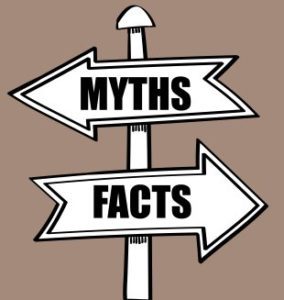
Poor assumptions can lead to myths instead of facts (image from shutterstock.com by Thinglass)
I am always on the lookout for experiences that can be turned into a “teachable moment.” Over the past two weeks, I have had two such experiences, so I thought I would write about them. The first one was a result of my article entitled Reflections on the Ark Encounter, which is a positive review of the latest attraction produced by Answers in Genesis. The day after it was published, I got a Facebook message from someone who had shared my post with a friend of hers. In reply, this friend asked if I was a “real” scientist. She assured him that I was and shared my Facebook page with him. She was rather taken aback when her friend sent her the following reply:
A mimeographed “PhD” from whatever fundamentalist “college” he sent his box tops to is not qualification to shine a real scientist’s shoes, let alone make claims about the natural world. Further, any parents who buy into this complete fiction, and indoctrinate their kids in this manner, are guilty of emotional and mental child abuse, and in my opinion should be prosecuted. I cant think of a better way to sabotage a child’s future in a modern, scientific and technological society.
This didn’t surprise me, of course. I am used to having my credentials questioned and being insulted because I don’t slavishly “toe the line” when it comes to today’s scientific consensus. That comes with the territory. Indeed, Dr. Dan Shechtman was asked to leave his research group because he dared to question the scientific consensus. Of course, the data eventually proved him to be correct and the scientific consensus to be wrong. However, that was until after being ridiculed as a “quasi-scientist” by one of the greatest chemists who has ever lived!
When I read that person’s reply, then, I just chuckled, because I knew how wrong he was. However, it got me thinking. This person is incorrect on so many levels, and the reason he is incorrect is because he has made some assumptions that are quite false. As a result, they have led him to false conclusions.
He seems to have assumed that there is no way a person could get a Ph.D. in science from a secular university and believe in young-earth creationism. Thus, he assumed I must have gotten my Ph.D. from a diploma mill that was probably a fundamentalist institution. Of course, that’s not correct. I received my Ph.D. from the University of Rochester, which is a purely secular university that I found to be openly hostile towards Christianity.
In addition, he assumes that children who are taught to question the scientific consensus are being harmed. He says that those children are having their future sabotaged in today’s modern, scientific and technological society. Once again, however, that is far from the truth. I have written before about how students who have been taught young-earth creationism do very well in college science courses (see here, here, here, here, here, here, and here). Far from sabotaging a student’s future, then, a young-earth creationist education prepares the student very well for university-level science.
In the end, this person’s conclusions couldn’t be more wrong, and it’s because his assumptions are wrong. Since he seems to be unwilling to question those assumptions, he is destined to be wrong about these things for a long, long time.
The second experience of mine that relates to this also comes from a blog article I wrote. In that article, I give a positive review of Dr. Douglas Axe’s latest book, Undeniable: How Biology Confirms Our Intuition That Life Is Designed. A person who lists his name only as “Hrafn” (an Old Norse name that means “Raven”) thinks that Dr. Axe’s book is irrelevant. Interestingly enough, however, he hasn’t read the book.
Of course, the fact that he hasn’t read the book doesn’t seem to keep him from evaluating it. In fact, in at least two comments, he claims that the book is making an Argument from Ignorance. Of course, nothing could be further from the truth. Dr. Axe’s book is based on experimentally-derived parameters that allow him to evaluate when a protein can evolve and when it can’t. There is no ignorance – just a hard, fact-based appraisal of when it is reasonable to look for answers other than those supplied by Neo-Darwinism.
Obviously, the irony is amazing. A person who is completely ignorant of what the book says actually claims that the book is making an Argument from Ignorance! Why? Because that is a common statement made in reference to the Intelligent Design movement, and he just assumes that the comment can be made in reference to Dr. Axe’s book, since Dr. Axe is a member of the intelligent design community. Once again, a faulty assumption leads him to an incorrect conclusion.
Now please understand what I am saying here. I am not saying that the person who thought I got my Ph.D. from a fundamentalist university is wrong about his belief in evolution. He could be right. I might be wrong on the origins issue. In the same way, Raven might not be wrong when it comes to his view on Intelligent Design. He might be right. The Intelligent Design community might be wrong.
However, both of them are certainly wrong on very specific points (where my Ph.D. comes from, the effects of a young-earth creationist education, and Dr. Axe making an Argument from Ignorance). Why? Because they are making faulty assumptions that they seem unwilling to question.
So at last we reach the teachable moment. We all make assumptions, and most likely some of those assumptions are wrong, which means they will lead us to false conclusions. Thus, we should be willing to question our assumptions. It’s a necessary part of striving for the truth!
August 8, 2016
A Really Undeniable Book, Written By a Real Scientist
A book that discusses some undeniable truths.
Dr. Douglas Axe is a very interesting scientist. He did his undergraduate work at the University of California, Berkeley and got his Ph.D. in chemical engineering from Caltech. His thesis was focused on molecular biology, which is why you find his scientific papers published in The Journal of Molecular Biology, PloS One, and Biochemistry. He is also a co-author on a paper that appeared in the Proceedings of the National Academy of Sciences of the United States of America. Currently, he is the director of the Biologic Institute, which is a research organization that encourages its scientists to do their research from an Intelligent Design point of view. He is also one of the authors of Science and Human Origins, a book that surveys the evidence for human evolution and concludes that humans cannot be the result of an unguided, neo-Darwinian process. I recently had the pleasure of reading his latest book, Undeniable: How Biology Confirms Our Intuition That Life Is Designed.The first thing you might notice about the book is its main title, which is the same as the main title of an error-riddled book written by Bill Nye. While Nye likes to call himself “The Science Guy,” some of his behavior is decidedly anti-science (see here and here, for example), and his book makes it clear that he doesn’t try to understand some of the issues that he discusses publicly. Unlike Nye’s book, this book is written by a real scientist who actually does educate himself on the issue about which he is writing. Indeed, most of what he writes in this book is directly related to the scientific work he has published over the years.
Before getting into the meat of the book, I think that a personal story he shares is worth noting. While he was a graduate student at Caltech, one of his final exams asked which biological molecule was likely the first “living” molecule. In other words, the person writing the exam wanted the student to relate what was currently the most fashionable conjecture regarding the origin of life. Here is how he describes his answer and its result:
I decided to give the expected answer in full and then – for extra credit – to state why I found that answer unconvincing. I explained why, contrary to the consensus view, I didn’t think any molecule has what would be needed to start life. As shrewd at that seemed at the time, I learned when my exam was returned (with points deducted) that we students were expected to not only know current thinking in biology but also accept it without resistance. We were there as much to be acculturated as educated. (kindle version, Chapter 1, emphasis his)
That is so true. If you ever wonder why so many scientists resist new thinking in the origins debate, it’s because they have been taught to resist it! Fortunately, some scientists (like Dr. Axe) don’t don’t take that lesson to heart. Instead, they do what scientists should do: question the existing paradigm when the data speak against it.
While he does have some other personal stories about his unconventional scientific career sprinkled throughout the book, he focuses on our intuition that the living organisms we see are the result of design. He starts with an interesting analogy. He says suppose someone claims to have found “oracle soup” – an alphabet soup that is boiled in a pot covered with a lid. When the lid is removed, a message appears at in the soup. That message gives complete instructions for building something new and useful. If you actually saw oracle soup in action, you would clearly not believe that random boiling produced those instructions. Yet, origin-of-life researchers want you to believe that the complex instructions for building the first “simple” life form came from random interactions in some sort of “primordial soup.”
Axe refers to “oracle soup” throughout the book, reminding the reader that you don’t have to be a scientist to be skeptical of certain scientific claims. For example, after describing how much information we can expect random processes to produce he says:
A three-letter word appearing in alphabet soup is worth mentioning, a five-letter word is worth photographing, and a seven-letter word is downright suspicious. (kindle version, Chapter 9)
In other words, when there is too much information, you should realize that there is no way random processes could have produced it. Sure, random processes can alter information, and sometimes they can alter it for the better. Indeed, he discusses how an evolutionary process in one of his experiments took a protein that didn’t do its job well and converted it into a protein that could do its job incredibly well. However, random processes could never have produced the original, poorly-working protein, because even a poorly-working protein represents significantly more information than could ever be produced by random chance.
Now please note that Axe doesn’t just tell you that a poorly-working protein cannot be produced by random chance and natural selection. He shows you why. He describes different systems that are analogous to how a biochemical system would “search” for a useful protein using random mutations acted on by natural selection. He then takes his own published scientific research on proteins and converts the numbers he got from that research into probabilities that are applicable to those analogous systems. In all cases, the numbers tell us that it is simply impossible for the search to be successful, unless the search field is narrowed down considerably.
His conclusion is that while evolution can “tinker” with a protein and make it better than it was initially, it can only do so when the starting chemical with which it is working already has a lot of the configuration that it needs to get the job done. In other words, evolution works well when the search field is narrowed down. However, to start from a protein that doesn’t do anything useful and try to make something useful out of it, the search field is impossibly large, and there is no way that random processes acted on by natural selection can get the job done.
While Axe’s book is not as wide-ranging as many other books that have been written about the origins issue, it is very powerful. It takes the “nuts and bolts” of evolution and demonstrates rather convincingly that there is simply no way that random processes could be the driving force. In other words, living things appear to be designed because they are, and while scientific research clearly confirms this fact, you don’t need to be a scientist to realize it.
August 5, 2016
Reflections on the Ark Encounter

A view of the Ark Encounter (click for a larger image)
Yesterday, I toured the Answers in Genesis Ark Encounter with my wife and a friend. I wanted to visit the encounter as soon as it opened, but because of trips to Italy and China, yesterday was the first opportunity we had. I didn’t know what to expect, so I went in with an open mind.
I originally thought the Ark Encounter would be like the Creation Museum, with a parking lot close to the entryway. I was wrong. When we parked and got out of the car, we could see the ark, but it was a long way off. A building in the parking lot served as a “bus terminal,” where we were picked up and taken to the Ark itself.
When we got off the bus, my first thought was, “Wow. That’s big.” I have seen many models of the Ark over the years, and they all attempt to give you an idea of how big it was, usually by having scale models of trucks or elephants beside it. However, there is simply no substitute for seeing the massive structure built to its actual dimensions! Answers in Genesis bills the Ark as the largest timber-framed structure in the world, and I can believe that. *
The entrance is cleverly designed to give visitors a great view of the Ark’s dimensions. You enter the Ark from below, which gives you stunning views of the bow, like this one:

The bow of the Ark as seen from the entrance. (click for a larger image)
The inside of the ark is equally impressive. There are many, many cages that give you an idea of how Noah’s family might have cared for the animals in the ark. The cages are designed so that liquid waste (and small solid waste) would fall into drainage areas so it could be easily removed. There are also water bottles made of clay that could give the animals a steady supply of fresh water. In addition, there are clay feed bottles that could deliver a steady supply of food to an animal over the course of several days.
Many of the cages have models of animals that might have been housed inside them. In addition, there are lots of recorded animal sounds that give you a feeling for what Noah’s family might have heard on the ark. There are also several displays that discuss various questions one might ask about the ark, such as how many animals there were, how eight people could take care of them, what the animals were fed, and how the fresh water and ventilation needs of the animals and passengers were met.
Overall, I was impressed with those exhibits. Most of the time, they reminded the visitors that we don’t have a lot of details, so much of what is presented is speculative and includes a lot of artistic license. Other exhibits, however, are based on well-known facts. For example, there is an excellent exhibit about flood legends from around the world, which I have always seen as strong evidence that the Flood was, indeed, worldwide. I couldn’t get a really good picture of it, because there were a lot of other visitors there, despite the fact that it was a weekday. This was the best I could do:
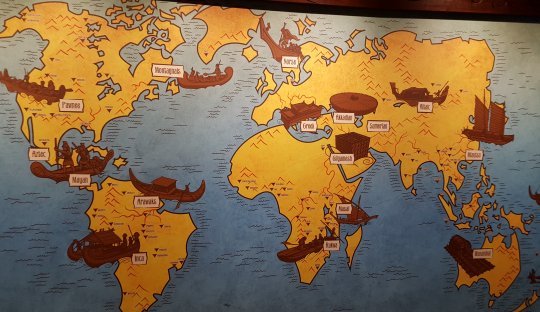
A display discussing the various flood legends found around the world (click for a larger image)
My favorite exhibit was a temporary one. It comes from the Museum of the Bible, and it displays some amazing Bibles like the Great Bible (printed in 1539) and the Matthew Bible (printed in 1537). There are also pages from historic Bibles that contain multiple languages (polyglot Bibles), and there is even a page from a copy of the Psalms (in Greek) that was made in the late 200s!

Fragment of a Greek copy of the Psalms from the late 200s AD (click for a larger image)
Now, there were parts of some displays that I didn’t like. For example, the pre-Flood world exhibit (which we had to wait in line for about 20 minutes in order to see) starts with a lovely display that recounts what was created on each day of the creation account of Genesis 1. It accurately quotes the Bible as saying that God saw what He had made and it was “very good” (Genesis 1:31).
However, the very next display described Adam and Eve in the Garden of Eden, and it used the word “perfect” several times. According to the display, even Adam and Eve’s marriage was “perfect.” Although many of my fellow young-earth creationists say that the original creation (or at least the Garden of Eden) was perfect, that’s an extra-Biblical idea which probably isn’t true. If God had wanted to say that His initial creation was perfect, He could have, as there are Hebrew words for perfect. Instead, He said that it was “very good,” which is quite different from perfect.
Now please understand that even the exhibits which had displays I didn’t like were, overall, very good (just not perfect). Thus, I don’t want my negative comments to overshadow the fact that I honestly think the Ark Encounter is something that everyone should see. As a young-earth creationist, it helped me better understand the worldwide Flood, the sheer magnitude of the Ark, and the various ways that Noah and his family could have taken care of all the animals on it. For example, I had never thought of this, but the Ark Encounter had an indoor garden that Noah and his family could have tended to supplement their food supply.
Even if you aren’t a young-earth creationist, however, I would think that the Ark Encounter would be something you could appreciate. Many old-earth creationists, for example, believe that the Flood was local, but they still believe that Noah and his family built an ark and cared for some animals on it. While the Ark Encounter does contain young-earth assumptions and presents some young-earth arguments, it is mostly about the Ark. Thus, I would think it would be useful to anyone who thinks the Ark was real.
Even those who don’t think the Ark was real should be able to appreciate the Ark Encounter. If nothing else, it will give you an accurate picture of the Ark that you are rejecting. The exhibits should at least show you that there are some reasonable answers to most of the objections you have against it. Those answers probably won’t change your mind, but they might give you a more realistic view of those who disagree with you on the issue.
As a result, I encourage everyone to visit the Ark Encounter. I think that regardless of their views on the Flood account given in the Bible, most people who can afford the admission fee will enjoy it and learn from it.
NOTE:
Return to Text
August 1, 2016
A Real-Life Example of The Prodigal Son

“The Return of the Prodigal Son” by Italian artist Pompeo Girolamo Batoni
Over the many years since I became a Christian, I have heard hundreds of sermons. Some were given by impeccably-credentialed theologians, others by intellectual philosophers, others by experienced scientists, and others by regular people who were honestly sharing what God had laid on their hearts. Most of them, of course, were given by pastors who have dedicated themselves to studying and explaining the Word of God. While I have learned from many of those sermons, only a precious few made such a lasting impact that I can remember them to this day. The sermon I heard yesterday, however, is one I will never forget. It was given by a student from Anderson University who has been leading the children’s ministry at our church. This young lady, who is still in the midst of finishing her undergraduate degree, shared a powerful message that brought me (and many others in the congregation) to tears.The main text of her message was the parable of The Prodigal Son, which is given in Luke 15:11-32. I have heard many, many, many sermons that used this parable as its main text. This one, however, was different. It gave a personal, real-life example of a father, his prodigal son, and the rest of his family. More importantly, this young lady was the prodigal son’s sister, and her father’s actions taught her (and the congregation at our church) what it really means to show the love of Jesus.
When this young lady was 13, her brother had a sexual relationship with a foster daughter who was living with her family. The foster daughter became pregnant, but no one knew. Her brother and the foster daughter conspired to accuse her father of molesting the foster daughter. It was all done so convincingly that this young lady believed her brother’s accusation, despite her father’s protestations of innocence. She was taken away from her family because of the allegations, and a restraining order was put in place so that her father could not see her.
Because of many things that happened over the next few months, it became clear to her that her father was, in fact, innocent, and that her brother had done the unthinkable: he had betrayed their entire family for his own selfish reasons. She eventually got to live with her mother again, and her father fought to get the restraining order lifted. That was eventually successful, so she at least got to see her father, but in the end, her father went to jail (where he is to this day) for a crime that he did not commit.
This young lady was, of course, furious at her brother for what he had done. She didn’t want anything to do with him, and I completely understand. Not surprisingly, her brother eventually went to prison for something else that he did, and then something incredible happened: Her father was transferred to the same prison where her brother was incarcerated. Taking this as a sign, her father arranged to have a meeting there with his son.
She told us that her father confessed to her that he didn’t know what he would do when he saw his son. Would he hit him, hug him, or both? But when they met, he simply held his arms open wide and said, “I love you.” If you’ve ever wondered what unconditional, Christlike love is, you don’t have to wonder anymore. This man’s actions personified it. It didn’t matter to him that his son falsely accused him of a horrible crime and, as a result, took him away from his family. In the end, what mattered is that he loves his son, and regardless of what happened, he needed his son to know that.
Her father’s actions changed this young lady’s attitude towards her brother. She said that she had been asking God to change him, but the fact is, her father showed her that she had to change. She had to put away the anger and replace it with love for her brother. She had to forgive him, just as her father had. She honestly told the congregation that there was no way she could do such a thing. However, Christ in her could, and now her family is in the process of healing.
Of course, the damage caused by her brother’s actions isn’t gone. Her father is still in prison, despite their attempts to work through the judicial system to have him released. She is getting married soon and is facing the real possibility that her father won’t even be able to attend her wedding. In other words, this story doesn’t have a “Disney” ending to it. However, it does have a Christian ending to it. Through the power of forgiveness, her family is being restored, despite the circumstances.
The next time I find it hard to forgive someone, I will remember this young lady’s amazing sermon. If she, her father, and her mother can all forgive her brother, I have absolutely no excuse.
July 28, 2016
A Desperate Attempt to Solve an Intractable Problem

Artist’s conception of a large asteroid hitting the earth (click for credit)
One of the many problems associated with an ancient earth is the young, faint sun. In a nutshell, we think we understand the way a star produces energy, and based on this understanding, a star starts off dim and grows brighter over time. Based on what we know, then, the sun should have been about 25% dimmer 3.8 billion years ago, when most evolutionists think life first emerged on earth. However, if the sun really were 25% dimmer back then, the earth would be far too frigid to support life.
This problem has been recognized for more than 40 years now, and evolutionists have worked hard on it (see here and here), but a solution has remained elusive. However, a recent paper has proposed a possible solution, and I found it interesting, because it illustrates exactly how desperate evolutionists are to get rid of this intractable problem.
In essence, the paper says that the way to fix the problem is to have earth pummeled by very large (greater than 100 kilometers in diameter) asteroids. They are so large that the authors call them “planetesimals”:
Planetesimals exceeding 100 km in diameter pummeled the early Earth for hundreds of Myr, resulting in large volumes of melt produced both by immediate depressurization and by subsequent mantle convection driven by the impact.
But wait a minute. Wouldn’t constant bombardment with large asteroids cause a problem for the formation of life? Not necessarily. Obviously, the impacts would inhibit the formation of life wherever they occurred, but they might make the earth as a whole more hospitable for life.
How? Well, impacts from large asteroids would melt lots of rock, making huge pools of lava. Those pools of lava would release the gases that had been trapped in the rock. Some of them would be greenhouse gases, like carbon dioxide and water vapor. Those greenhouse gases would then trap energy in the atmosphere, making the earth warmer than it otherwise would be.
Of course, there’s the rub. If the number of asteroid bombardments becomes too great (or the asteroids are too large), too many greenhouse gases would be released, and the earth would get too hot. If there aren’t enough bombardments (or the asteroids are too small), too few greenhouse gases would be released, and the earth wouldn’t get warm enough. In other words, the rate and severity of these impacts need to be balanced very precisely to keep the earth warm, but not too warm.
That’s not the end of the story, however. The greenhouse gases also have to leave the atmosphere over time. Otherwise, the earth would end up getting too hot as the sun got brighter and brighter. At the right time, then, the asteroid impacts would have to start decreasing, and the greenhouse gases would have to leave the atmosphere. Of course, these processes couldn’t happen too slowly or too quickly. Their rates would have to be coordinated with the increase in the sun’s brightness.
To me, this all seems very hard to believe. In order to keep the earth hospitable for life over evolutionary history, there has to be this perfectly-coordinated “dance” between asteroid impacts, greenhouse gas concentrations, and the brightness of the sun. Any misstep in the dance would destroy life on earth.
Of course, if you are committed to believing in an ancient earth, I guess any story, no matter how desperate, is better than an intractable problem.
July 26, 2016
CRISPR – A Gene-Editing Technology with Promise and Peril
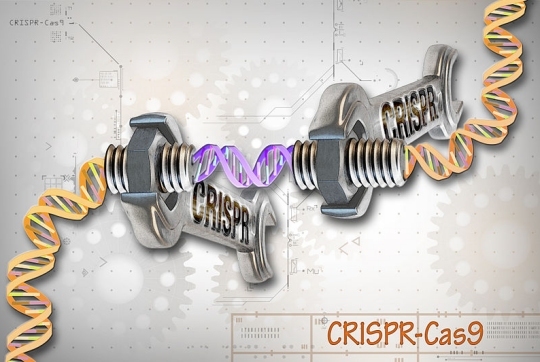
CRISPR, teamed up with Cas9, is a powerful gene-editing tool. (click for credit)
Not too long ago, a reader sent me an email that said:
I just found out about CRISPR and Cas9. From what I have learned about them they are very powerful and will lead to great things (good and terrible alike).
I was wondering if you could write a blog article on them when you get a chance. I would love to hear your perspective.
The reader is exactly right. CRISPR and Cas9 team up to make a powerful gene-editing tool that has incredible potential. While much of that potential is positive, some of it is quite negative.
To best understand the good and the bad of CRISPR and Cas9, you need to know what they are and what they can do together. CRISPR stands for “clustered regular interspaced short palindromic repeats.” Originally discovered in bacteria, it is a strand of RNA that is hooked to a CRISPR-associated protein, called a “Cas.” Cas9 is just one possible protein that can be associated with CRISPR, but it is the one that is most commonly used.
If your eyes are already glazing over, stick with me, because it’s important to understand how this works. RNA is a molecule that links to DNA. A specific RNA molecule targets a specific sequence of DNA. So, if you construct an RNA molecule correctly, it can search an entire DNA molecule, looking for a specific DNA sequence. It can then attach itself to that sequence. That’s what the RNA strand on CRISPR does. It is sometimes called “guide RNA,” because it guides the Cas9 protein to a specific part of an organism’s DNA. Consider the following illustration:
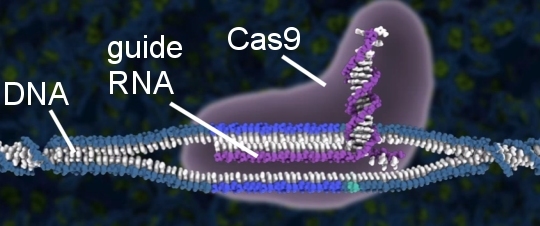
Illustration of CRISPR-Cas9 finding a DNA sequence
(taken from the video posted at the end of this article)
In the illustration, the guide RNA has found the DNA sequence that it was made to target. Since Cas9 is attached to the guide RNA, it is now positioned at a specific place in the DNA molecule.
Once the Cas9 gets positioned at the proper place, it cuts the DNA molecule, removing a portion of it. This leaves the DNA molecule in two pieces:
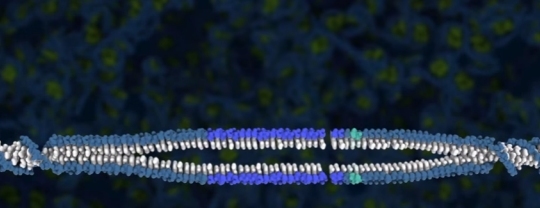
DNA after it has been cut by CRISPR-Cas9.
(taken from the video posted at the end of this article)
If that’s the end of the story, the organism’s DNA repair mechanisms stitch the two parts of the DNA together, and the result is the organism’s DNA with that one section removed.
There is, however, another possibility. Once the DNA has been cut, a new DNA sequence can be spliced into the DNA right where the cut is:
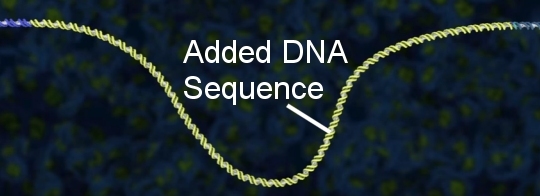
DNA with a new sequence that has been added as a result of CRISPR-Cas9’s action.
(taken from the video posted at the end of this article)
So in the end, CRISPR and Cas9 can be used to either “edit out” a portion of an organism’s DNA, or replace a portion of the organism’s DNA with something completely different. Obviously, that’s a powerful tool! Also, it is fairly easy to make, so it is also convenient to use. No wonder the journal Science named it 2015’s scientific breakthrough of the year.
Now think about the potential. Suppose a scientist wants to figure out the function of a specific gene. He or she can cut a section of the gene out, rendering it nonfunctional. The scientist can then study the effect this has on the cell or organism being studied. But that’s just the beginning. Some genetic diseases are the result of a gene having one bad section. Remove that bad section (or replace it with a good section of DNA), and you get rid of the disease. In other words, CRISPR can be used to treat genetic diseases.
Indeed, this has already been done. Mice were engineered to have a mutation that causes Duchenne muscular dystrophy, a genetic disease that affects 1 in every 5,000 newborn male children. Most who get the disease end up being confined to a wheelchair by age 10 and die before they are 40. Scientists made a CRISPR-Cas9 system that targeted the mutated portion of the mouse DNA and cut it out. After injecting the system into the bloodstream of a mouse, the mouse showed significant improvement. Obviously, this treatment is a long, long way from being used in people, but the mouse experiment at least demonstrates that such genetic treatments are possible.
While both of these applications (editing out genes to see what they do and treating genetic disease) hold great potential, there are dangers that have to be considered. First, it is always possible for CRISPR-Cas9 to make a mistake and edit the wrong portion of DNA. This is typically referred to as an “off-target alteration.” Second, we actually know precious little about DNA. Indeed, just a few years ago, the scientific consensus was that most of the human genome consisted of “junk DNA.” We now know how spectacularly wrong this evolution-inspired idea was, but it serves to illustrate how little we really understand DNA. As a result, even when CRISPR-Cas9 does exactly what it is supposed to do, there could be unintended consequences.
Finally, the most important possible danger associated with CRISPR-Cas9 involves the specific cells in which the DNA editing occurs. If CRISPR-Cas9 is used to target the cells in most tissue (like muscle tissue, nerve tissue, etc.), the only consequences that exist are for the specific organism being treated. However, if it is used to target the cells involved in reproduction (typically called “germline tissue”), the result of the gene editing will be passed on to subsequent generations. Given the possibilities of off-target alterations and unintended consequences, this could devastate an entire lineage!
Because of these very real dangers, several scientists (including some involved in the invention of CRISPR-Cas9) have called for prudence and caution. In their statement, they write:
At present, the potential safety and efficacy issues arising from the use of this technology must be thoroughly investigated and understood before any attempts at human engineering are sanctioned, if ever, for clinical testing. (emphasis mine)
I wholeheartedly agree. This new gene-editing technology holds great potential, both for good and for bad. Scientists need to exercise extreme caution in how it is used.
If you would like to see a video of how CRISPR-Cas9 works, this one was posted by one of its co-inventors:
July 20, 2016
Gospel of Jesus’ Wife Is a Fake
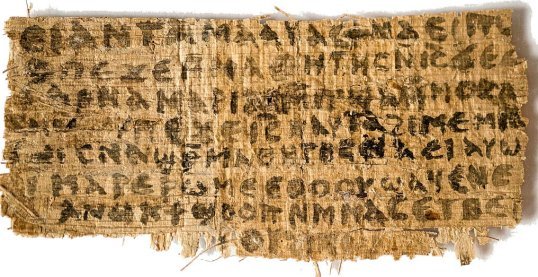
The papyrus fragment that is now known as ‘The Gospel of Jesus’ Wife.’ (click for credit)
I am in China right now, and I have been here for almost two weeks. However, internet access is sporadic (at best), which is why I haven’t added any articles recently. Things are a bit better today, though, so I thought I would share my thoughts on a story I recently ran across.
On September 18th, 2012 at the International Congress of Coptic Studies in Rome, Dr. Karen L. King announced the existence of an astounding 4-cm by 8-cm papyrus fragment. It contained what she thought was a 4th-century Coptic translation of a gospel that she suggested had probably been written in the late second century AD. While the discovery of any ancient papyrus that has writing on it is interesting, this particular fragment was especially interesting because it contained the following phrase:
Jesus said to them, ‘My wife…”
As a result, this papyrus fragment came to be known as “The Gospel of Jesus’ Wife.”
In a peer-reviewed paper that was later published in the Harvard Theological Review, Dr. King presented the results of several tests that had been done on the papyrus fragment. Those tests led her to conclude that it was from the 8th century AD and was not a forgery. In the same issue of the journal, however, another scholar wrote an article concluding that the papyrus was a forgery. The Vatican weighed in as well, dismissing the fragment as a “clumsy forgery.”
Since then, there has been a lot of discussion about the papyrus fragment, and a website was set up to provide all of the latest information about it. Based on subsequent tests done on the fragment and its ink, Dr. King became so convinced that the fragment is authentic that she told Time:
I’m basically hoping that we can move past the issue of forgery to questions about the significance of this fragment for the history of Christianity, for thinking about questions like, ‘Why does Jesus being married, or not, even matter? Why is it that people had such an incredible reaction to this?’
Fortunately, however, there were those who were unwilling to move past the issue of the fragment’s authenticity. One of those was a journalist, Ariel Sabar. Since he is not qualified to assess the fragment based on its physical characteristics or the writing that appears on it, he decided to investigate its record of ownership. He wanted to see if the facts line up with what Dr. King had been told about where it actually came from.
His investigation led to a string of lies and secrets that seemed to make it quite clear that the fragment isn’t authentic. Based on what he found, even Dr. King has admitted:
It tips the balance towards forgery.
Now, of course, it doesn’t surprise me at all that a papyrus fragment referring to Jesus’ wife is a forgery. What I find interesting is the way the issue was resolved. Experts had weighed in on both sides – some saying it was a forgery, some saying it was genuine, and some saying that they didn’t know. However, it wasn’t an expert who gave us the definitive evidence. It was a journalist.
There are times when a non-expert is best suited to resolve an academic debate, and the supposed Gospel of Jesus’ Wife provides us with an excellent example. Experts deserve respect, and their opinions should carry a lot of weight. However, sometimes, non-experts can do what the experts cannot.
July 7, 2016
Galileo and his Thermometer

Galileo’s thermometer (left) and a closeup of the tube (right).
If you read my two previous posts (here and here), you know that my wife and I were recently in Italy, and I was really inspired by some of the things I saw. The art and history are amazing, but for me, one of the major highlights of this visit to Italy was seeing the Galileo Museum. It is filled with scientific instruments and lecture demonstration equipment from the past, and seeing those things helped me to understand the sheer genius of the natural philosophers (scientists) who learned an enormous amount about Creation without the help of fancy, technological gadgets. Instead, they relied on their creativity and their physical insight.Consider, for example, the glass piece pictured on the far left. It consists of a small vessel, a long, narrow tube rising up from the vessel, and a small bulb at the top of the tube. Believe it or not, that’s a thermometer. Actually, it is more properly called a “thermoscope,” and the first one was designed by Galileo (with the help of some other natural philosophers) in 1593.* Until that time, it was difficult to make any systematic measurement of temperature. People could tell whether it was hot, warm, cool, or cold, of course, but they couldn’t make precise measurements of how hot, warm, cool, or cold it was.
In the late 1500s, Galileo came up with an ingenious solution. He understood that air expanded when it was warmed and contracted when it was cooled. He decided to use that fact to get an accurate measurement of the change in temperature. He designed a device similar to the one above, in which water filled the bottom vessel and ran partway up the thin tube. When the surroundings warmed up, the air above the water (in the tube and in the bulb at the top) expanded, and that pushed the water down the tube. When the surroundings cooled, the air above the water contracted, and that pulled water up the tube.
In other words, the higher the water climbed in the tube, the lower the temperature. By making tiny marks on the side of the tube (shown in the right-hand portion of the picture at the top of this post), he could assign a number to the water’s height. This allowed him to accurately measure changes in temperature. In my elementary science book, Science in the Scientific Revolution, I have students make a very simple version of Galileo’s thermometer with water, a glass, and a plastic bottle.
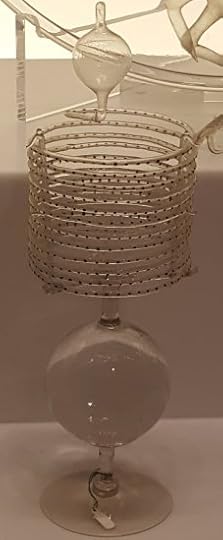
A clever variation on Galileo’s thermometer.
A major drawback of Galileo’s thermometer is that it must be very tall to measure large changes in temperature. While at the Galileo museum, however, I saw a very clever way of getting around that problem, which is shown in the picture on the left. Instead of a tall, straight tube, this thermometer’s tube is a spiral. That way, the water still can travel a long distance through the tube, but the device isn’t absurdly tall. As soon as I saw this device, I thought, “Of course. What an ingenious way of getting around the height problem.”Despite the fact that I understood exactly how this variation on Galileo’s thermometer would work and why it was superior to the original design, I doubt that I would have ever come up with it on my own. I’m simply not that clever. However, Galileo and the natural philosophers of his day were. The more I learn about people like Galileo, the more I appreciate how intelligent the great thinkers of the past were. Contrary to popular belief, I think it’s possible that they were actually smarter than we are today.
NOTE:
Jay L. Wile's Blog
- Jay L. Wile's profile
- 31 followers


